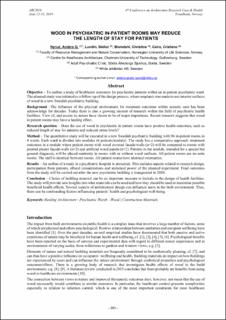| dc.contributor.author | Nyrud, Anders Q. | |
| dc.contributor.author | Lundin, Stefan | |
| dc.contributor.author | Blomdahl, Christina | |
| dc.contributor.author | Caira, Cristiana | |
| dc.date.accessioned | 2022-01-31T19:00:47Z | |
| dc.date.available | 2022-01-31T19:00:47Z | |
| dc.date.issued | 2021 | |
| dc.identifier.isbn | 978-82-536-1718-3 | |
| dc.identifier.issn | 2387-4295 | |
| dc.identifier.uri | https://hdl.handle.net/11250/2976130 | |
| dc.description.abstract | Objective – To outline a study of healthcare outcomes for psychiatric patients within an in-patient psychiatric ward. The planned study was initiated as a follow-up of the design process, where emphasis was made to use interior surfaces of wood in a new Swedish psychiatric building.
Background –The influence of the physical environment for treatment outcomes within somatic care has been acknowledge for decades. Today there is also a growing amount of research within the field of psychiatric health facilities. View of, and access to, nature have shown to be of major importance. Recent research suggests that wood in patient rooms may have a healing effect.
Research question – Does the use of wood in psychiatric in-patient rooms have positive health outcomes, such as reduced length of stay for patients and reduced stress levels?
Method – The quantitative study will be executed in a new Swedish psychiatric building with 96 in-patient rooms in 4 wards. Each ward is divided into modules (6 patients/module). The study has a comparative approach: treatment outcomes in a module where patient rooms with wood covered facade-walls (n=2) will be compared to rooms with painted plaster façade-walls (n=2) and artificial wood panels (n=2). Patients in the module, intended for a special but general diagnosis, will be placed randomly in rooms with or without wood surfaces. All patient rooms are én-suite rooms. The staff is identical between rooms. All patient rooms have identical orientation.
Results – An outline of a study in a psychiatric hospital is presented. This includes aspects related to research design, participation from patients, ethical considerations and statistical power of the planned experiment. Final outcomes from the study will be carried out after the new psychiatric building is inaugurated in 2020.
Conclusion – Choice of building material can be an important measure to include in the design of health facilities. The study will provide new insights into what materials can be used and how they should be used to maximise possible beneficial health effects. Several aspects of architectural design can influence users in the built environment. Thus, there can be confounding factors influencing patients´ health and psychological well-being. | |
| dc.language.iso | eng | |
| dc.publisher | SINTEF Academic Press | |
| dc.relation.ispartof | ARCH19 June 12–13, 2019 – Trondheim, Norway. Proceedings from the 4th Conference on Architecture Research Care & Health | |
| dc.relation.ispartofseries | SINTEF Proceedings;8 | |
| dc.rights | CC BY 4.0 | |
| dc.rights.uri | https://creativecommons.org/licenses/by/4.0/ | |
| dc.subject | Healing Architecture | |
| dc.subject | Psychiatric Wards | |
| dc.subject | Wood | |
| dc.subject | Construction Materials | |
| dc.title | Wood in psychiatric in-patient rooms may reduce the length of stay for patients | |
| dc.type | Chapter | |
| dc.type | Peer reviewed | |
| dc.type | Conference object | |
| dc.description.version | publishedVersion | |
| dc.rights.holder | © 2021 The Authors. Published by SINTEF Academic Press. | |

